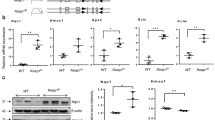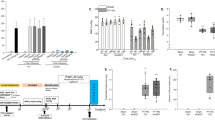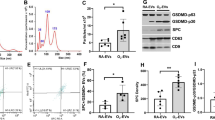Abstract
Cytochrome P450 (CYP) inhibition with cimetidine reduces hyperoxic lung injury in young lambs. Nitric oxide (NO), also a CYP inhibitor, has been shown to either aggravate or protect against oxidant stress depending on experimental context. The objective of this study was to determine whether NO, like cimetidine, would protect young lambs against hyperoxic lung injury, and whether its effect was associated with CYP inhibition. Three groups of lambs were studied: 1) room air exposure, 2) >95% O2, and 3) >95% O2 plus inhaled NO. After 72 h, hyperoxia alone resulted in a significant increase in arterial Pco2 and number of polymorphonuclear leukocytes in bronchoalveolar lavage (BAL), and a significant decrease in arterial/alveolar O2 tension (a/A). The addition of inhaled NO significantly decreased the hypercarbia and BAL polymorphonuclear cellular response associated with hyperoxia but had no beneficial effect on a/A ratio. There were no significant differences in F2-isoprostanes or isofurans (markers of lipid peroxidation) measured in BAL or lung tissue among study groups. No intergroup differences were detected in BAL epoxyeicosatrienoic acid levels (index of CYP activity). The results of this study indicate that hypercarbia and inflammation accompanying hyperoxic lung injury in young lambs can be attenuated by inhaled NO. However, this study provides no direct evidence that NO is inhibiting CYP-mediated oxidant lung injury.
Similar content being viewed by others
Log in or create a free account to read this content
Gain free access to this article, as well as selected content from this journal and more on nature.com
or
Abbreviations
- BAL:
-
bronchoalveolar lavage
- bld:
-
below limits of detection
- CYP:
-
cytochrome P450
- EET:
-
14,15-epoxyeicosatrienoic acids
- NICI-GCMS:
-
negative ion-chemical ionization-gas chromatography-mass spectrometry
- NO:
-
nitric oxide
- PMN:
-
polymorphonuclear leukocytes
References
Hazinski TA, France M, Kennedy KA, Hansen TN 1989 Cimetidine reduces hyperoxic lung injury in lambs. J Appl Physiol 67: 2586–2592
Hazinski TA, Noisin E, Hamon I, DeMatteo A 1995 Sheep lung cytochrome P450IA1 (CYP1A1): cDNA cloning and transcriptional regulation by oxygen tension. J Clin Invest 96: 2083–2089
Tindberg N, Ingelman-Sundberg M 1989 Cytochrome P-450 and oxygen toxicity. Oxygen-dependent induction of ethanol-inducible cytochrome P-450 (IIE1) in rat liver and lung. Biochemistry 28: 4499–4504
Bysani GK, Kennedy TP, Ky N, Rao NV, Blaze CA, Hoidal JR 1990 Role of cytochrome P-450 in reperfusion injury of the rabbit lung. J Clin Invest 86: 1434–1441
Zeldin DC, Plitman JD, Kobayashi J, Miller RF, Snapper JR, Falck JR, Szarek JL, Philpot RM, Capdevila JH 1995 The rabbit pulmonary cytochrome P450 arachidonic acid metabolic pathway: characterization and significance. J Clin Invest 95: 2150–2160
Kinsella JP, Abman SH 2000 Inhaled nitric oxide: current and future uses in neonates. Semin Perinatol 24: 387–395
Clark RH, Kueser TJ, Walker MW, Southgate WM, Huckaby JL, Perez JA, Roy BJ, Keszler M, Kinsella JP 2000 Low-dose nitric oxide therapy for persistent pulmonary hypertension of the newborn. Clinical Inhaled Nitric Oxide Research Group. N Engl J Med 342: 469–474
Stadler J, Trockfeld J, Schmalix WA, Brill T, Siewert JR, Greim H, Doehmer J 1994 Inhibition of cytochromes P4501A by nitric oxide. Proc Natl Acad Sci U S A 91: 3559–3563
1990 Bronchoalveolar lavage constituents in healthy individuals, idiopathic pulmonary fibrosis, and selected comparison groups. The BAL Cooperative Group Steering Committee. Am Rev Respir Dis 141: S169–S202
Roberts LJ, Morrow JD 1994 Isoprostanes. Novel markers of endogenous lipid peroxidation and potential mediators of oxidant injury. Ann N Y Acad Sci 744: 237–242
Fessel JP, Porter NA, Moore KP, Sheller JR, Roberts LJ 2nd 2002 Discovery of lipid peroxidation products formed in vivo with a substituted tetrahydrofuran ring (isofurans) that are favored by increased oxygen tension. Proc Natl Acad Sci U S A 99: 16713–16718
McElroy MC, Wiener-Kronish JP, Miyazaki H, Sawa T, Modelska K, Dobbs LG, Pittet JF 1997 Nitric oxide attenuates lung endothelial injury caused by sublethal hyperoxia in rats. Am J Physiol 272: L631–L638
Skimming JW, Banner MJ, Spalding HK, Jaeger MJ, Burchfield DJ, Davenport PW 2001 Nitric oxide inhalation increases alveolar gas exchange by decreasing deadspace volume. Crit Care Med 29: 1195–1200
Martin RJ, Mhanna MJ, Haxhiu MA 2002 The role of endogenous and exogenous nitric oxide on airway function. Semin Perinatol 26: 432–438
Hallman M, Bry K 1996 Nitric oxide and lung surfactant. Semin Perinatol 20: 173–185
Barbera JA, Roger N, Roca J, Rovira I, Higenbottam TW, Rodriguez-Roisin R 1996 Worsening of pulmonary gas exchange with nitric oxide inhalation in chronic obstructive pulmonary disease. Lancet 347: 436–440
Hopkins SR, Johnson EC, Richardson RS, Wagner H, De Rosa M, Wagner PD 1997 Effects of inhaled nitric oxide on gas exchange in lungs with shunt or poorly ventilated areas. Am J Respir Crit Care Med 156: 484–491
Heinonen E, Nyman G, Merilainen P, Hogman M 2002 Effect of different pulses of nitric oxide on venous admixture in the anaesthetized horse. Br J Anaesth 88: 394–398
Lewis RE, Granger HJ 1986 Neutrophil-dependent mediation of microvascular permeability. Fed Proc 45: 109–113
Kinsella JP, Parker TA, Galan H, Sheridan BC, Halbower AC, Abman SH 1997 Effects of inhaled nitric oxide on pulmonary edema and lung neutrophil accumulation in severe experimental hyaline membrane disease. Pediatr Res 41: 457–463
Guidot DM, Repine MJ, Hybertson BM, Repine JE 1995 Inhaled nitric oxide prevents neutrophil-mediated, oxygen radical-dependent leak in isolated rat lungs. Am J Physiol 269: L2–L5
Kang JL, Park W, Pack IS, Lee HS, Kim MJ, Lim CM, Koh Y 2002 Inhaled nitric oxide attenuates acute lung injury via inhibition of nuclear factor-kappa B and inflammation. J Appl Physiol 92: 795–801
Tavares-Murta BM, Machado JS, Ferreira SH, Cunha FQ 2001 Nitric oxide mediates the inhibition of neutrophil migration induced by systemic administration of LPS. Inflammation 25: 247–253
Ekekezie II, Thibeault DW, Zwick DL, Rezaiekhaligh MH, Mabry SM, Morgan RE, Norberg M, Truog WE 2000 Independent and combined effects of prolonged inhaled nitric oxide and oxygen on lung inflammation in newborn piglets. Biol Neonate 77: 37–44
Ekekezie II, Thibeault DW, Rezaeikhaligh MH, Mabry SM, Norberg M, Reddy GK, Youssef J, Truog WE 2000 High-dose inhaled nitric oxide and hyperoxia increases lung collagen accumulation in piglets. Biol Neonate 78: 198–206
Nelin LD, Welty SE, Morrisey JF, Gotuaco C, Dawson CA 1998 Nitric oxide increases the survival of rats with a high oxygen exposure. Pediatr Res 43: 727–732
Schreiber MD, Gin-Mestan K, Marks JD, Huo D, Lee G, Srisuparp P 2003 Inhaled nitric oxide in premature infants with the respiratory distress syndrome. N Engl J Med 349: 2099–2107
Friel JK, Friesen RW, Harding SV, Roberts LJ 2004 Evidence of oxidative stress in full-term healthy infants. Pediatr Res 56: 878–882
Ahola T, Fellman V, Kjellmer I, Raivio KO, Lapatto R 2004 Plasma 8-isoprostane is increased in preterm infants who develop bronchopulmonary dysplasia or periventricular leukomalacia. Pediatr Res 56: 88–93
Montuschi P, Ciabattoni G, Paredi P, Pantelidis P, du Bois RM, Kharitonov SA, Barnes PJ 1998 8-Isoprostane as a biomarker of oxidative stress in interstitial lung diseases. Am J Respir Crit Care Med 158: 1524–1527
Author information
Authors and Affiliations
Corresponding author
Additional information
Supported by grants HL56697, GM42056, GM15431, and DK26657 from NIH and the National Institute of Environmental Health Sciences Division of Intramural Research
Rights and permissions
About this article
Cite this article
Cotton, R., Sundell, H., Zeldin, D. et al. Inhaled Nitric Oxide Attenuates Hyperoxic Lung Injury in Lambs. Pediatr Res 59, 142–146 (2006). https://doi.org/10.1203/01.pdr.0000191815.60293.cc
Received:
Accepted:
Issue date:
DOI: https://doi.org/10.1203/01.pdr.0000191815.60293.cc
This article is cited by
-
L-citrulline supplementation reverses the impaired airway relaxation in neonatal rats exposed to hyperoxia
Respiratory Research (2012)
-
Inhaled nitric oxide increases endothelial permeability in Pseudomonas aeruginosa pneumonia
Intensive Care Medicine (2007)



